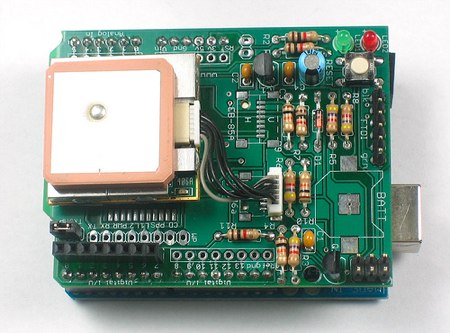
ladyada continues to produce more and more interesting Arduino shields. This new GPS logger plugs into a standard Arduino board and has support for four different GPS receiver modules. On the backside of the board is an SD card slot where it stores the coordinates in a text file. The total runtime can vary from five hours to twenty depending on how you choose to power the device and how you use the device. How often you read the device and whether you maintain the GPS lock will affect the power consumption. Like all of ladyada’s projects, you’ll find a great construction guide and example code on her site.
Month: June 2008
Bittorrent Admin Convicted By Federal Jury

[Daniel Dove], administrator of the site EliteTorrents.org, has been convicted of conspiracy and felony copyright infringement. Running a bittorrent tracker isn’t in itself illegal, but [Dove] apparently recruited seeders and distributed the initial illegal copies to them from his own server. From the press release, it seems the Justice Department is quite tickled with finally getting a conviction in a P2P case after a jury trial.
[photo: nrkbeta]
Defcon 16 Schedule Finalized

If you were waiting to finalize you travel plans, now’s the time; Defcon has published the final speaking schedule. The conference starts Friday August 8th in Las Vegas, NV and continues through Sunday with four separate speaking tracks. There’s quite a few talks we’re looking forward to: Silicon guru [Christopher Tarnovsky] from Flylogic will be hosting a breakout session on smartcard security. [Gadi Evron] will talk about the security implications of biological implants in the future. [Thomas Wilhelm] is going to cover building a mobile hacker space and the vehicle related hacks it requires.
Plants As Speakers

You can make pretty much anything a speaker by vibrating it. Japanese engineer, [Keiji Koga], has been working for many years to perfect his plant based sound transmission system. The voice coil is at the bottom of the plant container and transfers sound up the stalk to the leaves. It’s and interesting idea, but we can’t imagine it sounds much better than vibrating a rigid surface.
[via io9]
Anti-paparazzi Sunglasses
UPDATE: Video can also be found here.
Ah, the life of the work-a-day hacker: sure, it’s glamorous, but all the paparazzi dogging your every step can get unbearably stressful. Thankfully, you have a recourse with these anti-paparazzi sunglasses. They work by mounting two small infrared lights on the front. The wearer is completely inconspicuous to the human eye, but cameras only see a big white blur where your face should be.
Building them is a snap: just take a pair of sunglasses, attach two small but powerful IR LEDS to two pairs of wires, one wire per LED. Then attach the LEDs to the glasses; the video suggests making a hole in the rim of the glasses to embed the LEDs. Glue or otherwise affix the wires to the temples of the glasses. At the end of the temples, attach lithium batteries. They should make contact with the black wire, but the red wires should be left suspended near the batteries without making contact. When you put them on the red wire makes contact, turning the lights on. It’s functional, but we’re thinking that installing an on/off switch would be more elegant and it would allow you to wear them without depleting the batteries.
[via BoingBoing]
Logic Probe Kit

Logic probes can be anything from useful to critical depending on the project, but if you don’t have one already, why not try building one? Instructables has a guide to building a logic probe using a PCB, an assorted lot of resistors, capacitors, regulators, DIP sockets, a 9V battery clip (and 9V battery), and a hex inverter. Instead of using an LED like other simple logic probes, though, this kit uses a 7 segment LED display to show whether logic high (H) or low (L). The schematic makes putting this together only slightly more complicated than snapping Legos together. Of course, the resulting device is not as versatile as a LogicPort logic analyzer, but it is still useful.
AirPiano: Touch Free IR Piano
[youtube=http://www.youtube.com/watch?v=Gh4Ovsh2DZY&hl=en&rel=0&color1=0x3a3a3a&color2=0x999999]
We were excited to learn of [Omer Yosha]’s AirPiano, but being the persnickety nerds we are, we think its more like a theremin than a piano. The device lets users play 24 different notes with a wave of the hand over the AirPiano. The “keys” are arranged in a matrix of three tiers with eight notes per tier; if the user sustains his or her hand over the AirPiano, the corresponding note is sustained.
It’s construction is relatively simple: an Arduino, several infrared sensors, and LEDs corresponding to the notes make up the device. It doesn’t have any built-in audio hardware at all, so it’s most basic use is as a MIDI controller. Still, it is essentially an unspecified input device, so it could theoretically be used for other purposes. For us, it’s fun to just watch the AirPiano in action.











